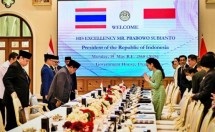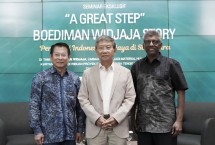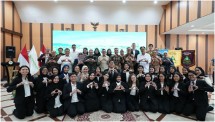BMKG Prediction Summer Fall May-June, Palm Industry Commitment Prevent Karhutla
By : Hariyanto And Aldo Bella Putra | Saturday, May 19 2018 - 23:00 IWST

Kebun Kelapa Sawit (Ist)
INDUSTRY.co.id - Jakarta - National oil palm industry is committed to prevent forest and land fires following predictions by the Meteorology, Climatology and Geophysics Agency (BMKG) which expects the summer to fall in early May and June 2018 and peak in August-September 2018.
President Director of Minamas Plantation Haryanto Tedjawidjaja said it was ready to face the coming summer through Mandiri Village Cegah Api to prevent forest and land fires.
According to him, preventing the fire is done as a commitment of plantation companies in building plantations with the concept of "zero burning" or clearing land without burning.
Even to prevent the occurrence of fire is also carried out around a subsidiary with a 5 KM radius of fire free.
"We and our subsidiaries continue to coordinate and communicate with all parties to monitor the occurrence of hotspots in their respective areas, especially those located around community plantations," he said in Jakarta, Friday (18/05/2018).
This fire free commitment, he said, is not only done in internal company and its subsidiaries but also outside the company's scope is by doing the program together with the surrounding community.
The "Desa Mandiri Cegah Api" program, according to him, is one of the Minamas Plantation program with the community starting in 2014 in four villages around the subsidiary. Among them are PT Bhumireksa Nusasejati (PT BNS), in Inhil District, Riau. The four villages are villages with broad peat land topography.
"Even to maximize the fire prevention, we also cooperate with the University of Riau (Unri) with the pattern of community assistance with the aim of changing community behavior in clearing the land with the pattern without burning," said Haryanto.
He revealed that prior to the implementation of the program, Unri reported that 77 percent of villagers were forced to clear land for farming on peatlands by burning and leaving behind burning. Once this program is implemented, the number of hotspots is reduced from 40 in 2013-2014 to just one in 2015-2016.
Read Also
ISPO to Leverage Palm Oil Competitiveness Level?
Rebranding Indonesian Palm Oil: A Lesson of Starbucks Traceability…
Ministry of Trade Holds 12th Gambir Trade Talk 'Indonesia's Foreign…
Wilmar International and LDC Visit Orangutan Conservation Area on…
Sawit Sumbermas Sarana Prioritizes Commitment to Protect the Environment…
Today's Industry

Senin, 09 Juni 2025 - 14:22 WIB
Savyavasa and Permata Bank Launch Exclusive Foreign Mortgage Program
Savyavasa, a luxury residential development by Swire Properties and JSI Group under PT Jantra Swarna Dipta, in collaboration with Permata Bank, presents a new solution for foreign nationals…

Rabu, 21 Mei 2025 - 10:09 WIB
Indonesia, Thailand Sign MoU on Health Sector, Focusing on Global Capacity, Collaboration
As a part of President Prabowo Subianto’s official visit to Thailand, both countries signed a Memorandum of Understanding (MoU) on health sector, in an effort to strengthen bilateral cooperation…

Rabu, 21 Mei 2025 - 10:06 WIB
Indonesia, Thailand Deepen Cooperation on Security, Trade, and Regional Stability
resident Prabowo Subianto has reaffirmed Indonesia’s strong commitment to deepening bilateral relations with Thailand during the meeting with Thailand’s Prime Minister Paetongtarn Shinawatra…

Selasa, 20 Mei 2025 - 12:44 WIB
Boediman Widjaja's Technology Ready to be Adopted in Jababeka Industrial Estate (KIJA)
In an exclusive seminar entitled "A Great Step: Boediman Widjaja Story - Going from Indonesia, Thriving in Singapore" held at the President Lounge, Menara Batavia, Boediman Widjaja, Founder…

Jumat, 02 Mei 2025 - 10:46 WIB
Binawan and Government Support Indonesian Nurses in Europe through Scholarships
In the midst of the viral #KaburAjaDulu hashtag as a symbol of the young generation's disappointment with domestic working conditions, Binawan responded with real action: dispatching Indonesian…

















News Comment